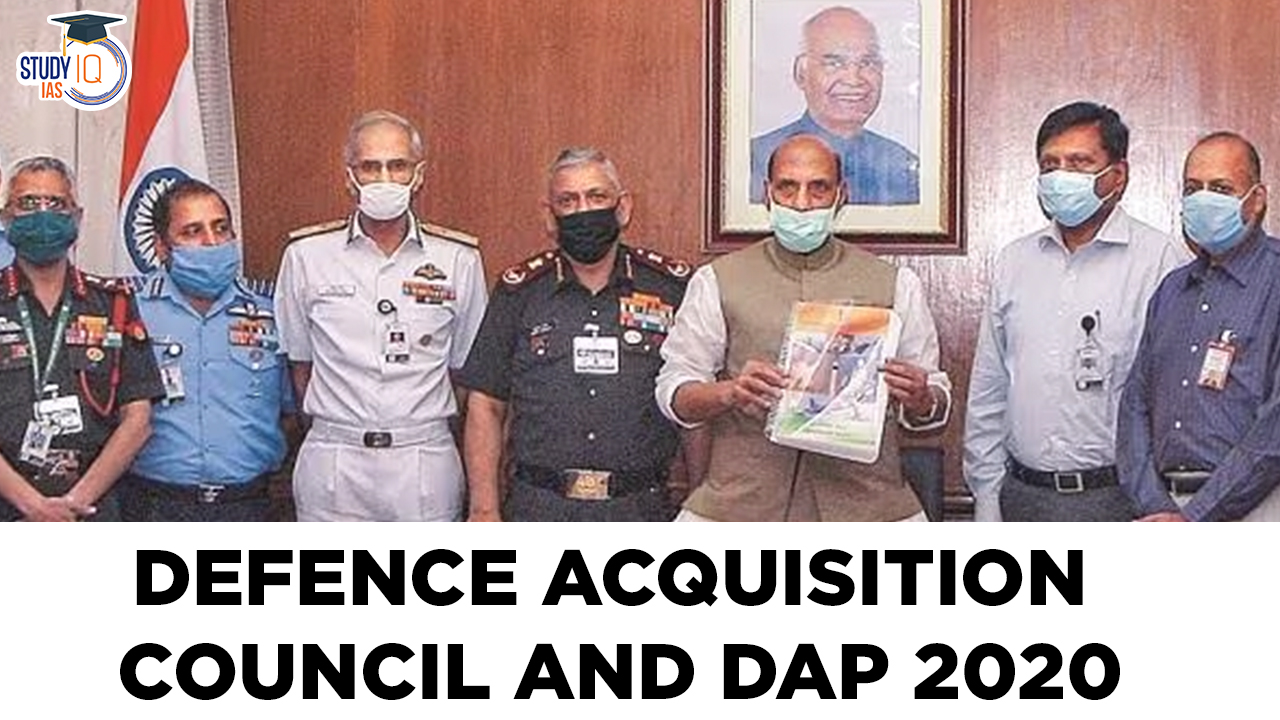Table of Contents
Context: The Defence Acquisition Council (DAC) accorded Acceptance of Necessity (AoN), the first step in the procurement process, for proposals worth ₹84,560 crore.
About Defence Acquisition Council
Defence procurement in India is at present governed by the Defense Procurement Procedure 2016 and the Defense Acquisition Procedure 2020.
| Aspect | Details |
| What is it? | Highest decision-making body in the Ministry of Defence for procurement. |
| Chairman | Defence Minister. |
| Members | Chief of Defence Staff (CDS), Chiefs of Army, Navy, and Air Force. |
| Objective | To ensure expeditious procurement for the armed forces. |
| Formation | Formed in 2001 post Kargil War, following the recommendations of the Group of Ministers on ‘Reforming the National Security System’. |
| Functions |
|
Defence Acquisition Procedure 2020
- It outlines a policy for banning the import of certain weapons and platforms.
- The policy emphasises increasing Foreign Direct Investment in defence manufacturing and prioritises the indigenization of manufacturing processes.
- The procedure introduces innovative concepts such as integrating artificial intelligence in defence systems, utilising indigenous software, and encouraging innovation among Start-ups and MSMEs for defence procurement.
- DAP 2020 categorises procurement into several types: Buy (Indian – Indigenously Designed Developed and Manufactured), Buy (Indian), Buy and Make (Indian), Buy (Global – Manufacture in India), and Buy (Global).
- The policy raises the minimum Indigenous Content requirement in all defence projects, mandating an increase from the previous 40%-50% to a new threshold of 50%-60%.
- In cases of procurement categorised as Buy (Global), it allows foreign vendors to meet a 30% Indigenous Content threshold by partnering with Indian companies.
We’re now on WhatsApp. Click to Join
Key Features of Procurement Policy
- Promote Indigenous Capabilities: Defence Procurement Procedure 2016 introduced a new category of capital procurement ‘Buy {Indian-IDDM (Indigenously Designed, Developed and Manufactured)}’ to promote indigenous design and development of defence equipment.
- Make and Innovation: Make I/II/III are government and industry-funded efforts towards achieving greater indigenization of manufacturing. iDEX (Innovation for Defense Excellence) set up under DAP 2020 aims to provide support to Startup industries working towards Defense Indigenisation.
- Private Participation in Defense: Defense Acquisition Procedure 2020 provided a level playing field for Indian Private Defense Industries
- Capital acquisition prescribed under DAP 2020 allowed Indian companies both private and public to participate in the acquisition process.
- Indian private shipyards have also been made eligible for bidding on projects along with PSU shipyards.
- Trial and testing procedures have been overhauled to nurture competition based on principles of transparency, fairness and equal opportunities for all.
- Industry-friendly commercial terms have been introduced
- Local procurement: Dept of Defense production notifies items under Public Procurement Order 2017, items for which procurement shall be done from local suppliers only, irrespective of the purchase value.
- Providing access to critical technology: Offset reforms have been included in the Defence Acquisition Procedure (DAP) 2020, to attract Investment and Technology for defence manufacturing.
- Investments have been incentivized through higher multipliers for the transfer of technology/critical technologies under offset discharge.
- Increased FDI in Defense sector: FDI in Defense manufacturing was increased to 74% under the automatic route and 100% under the Government route to increase production in the defence sector.
- Encourage MSME in Defense sector: DPP 2016 provided greater impetus to the Micro, Small and Medium Enterprises (MSMEs), by reserving certain categories of ‘Make’ projects exclusively for them


 Places in News for UPSC 2025 for Prelims...
Places in News for UPSC 2025 for Prelims...
 New Phase of Operation Chakra to Combat ...
New Phase of Operation Chakra to Combat ...
 Soyuz Aircraft: History, Design and Sign...
Soyuz Aircraft: History, Design and Sign...





















